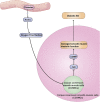Advances in physical diagnosis and treatment of male erectile dysfunction
- PMID: 36699684
- PMCID: PMC9868413
- DOI: 10.3389/fphys.2022.1096741
Advances in physical diagnosis and treatment of male erectile dysfunction
Abstract
Erectile dysfunction (ED) is the most common male sexual dysfunction by far and the prevalence is increasing year after year. As technology advances, a wide range of physical diagnosis tools and therapeutic approaches have been developed for ED. At present, typical diagnostic devices include erection basic parameter measuring instrument, erection hardness quantitative analysis system, hemodynamic testing equipment, nocturnal erection measuring instrument, nerve conduction testing equipment, etc. At present, the most commonly used treatment for ED is pharmacological therapy represented by phosphodiesterase five inhibitors (PDE5i). As a first-line drug in clinical, PDE5i has outstanding clinical effects, but there are still some problems that deserve the attention of researchers, such as cost issues and some side effects, like visual disturbances, indigestion, myalgia, and back pain, as well as some non-response rates. Some patients have to consider alternative treatments. Moreover, the efficacy in some angiogenic EDs (diabetes and cardiovascular disease) has not met expectations, so there is still a need to continuously develop new methods that can improve hemodynamics. While drug have now been shown to be effective in treating ED, they only control symptoms and do not restore function in most cases. The increasing prevalence of ED also makes us more motivated to find safer, more effective, and simpler treatments. The exploration of relevant mechanisms can also serve as a springboard for the development of more clinically meaningful physiotherapy approaches. Therefore, people are currently devoted to studying the effects of physical therapy and physical therapy combined with drug therapy on ED. We reviewed the diagnosis of ED and related physical therapy methods, and explored the pathogenesis of ED. In our opinion, these treatment methods could help many ED patients recover fully or partially from ED within the next few decades.
Keywords: dual-energy CT Arteriography; erectile dysfunction; low-intensity extracorporeal shock wave therapy; pathophysiological mechanisms; penile cavernosography; pharmaco penile duplex ultrasonography; physical diagnosis; physical treatment.
Copyright © 2023 Pang, Pan, Xu, Ma, Wang, Xu, Wang and Zang.
Conflict of interest statement
The authors declare that the research was conducted in the absence of any commercial or financial relationships that could be construed as a potential conflict of interest.
Figures




Similar articles
-
Low-intensity extracorporeal shock wave therapy--a novel effective treatment for erectile dysfunction in severe ED patients who respond poorly to PDE5 inhibitor therapy.J Sex Med. 2012 Jan;9(1):259-64. doi: 10.1111/j.1743-6109.2011.02498.x. Epub 2011 Oct 18. J Sex Med. 2012. PMID: 22008059 Clinical Trial.
-
Low intensity extracorporeal shockwave therapy for erectile dysfunction: a study in an Indian population.Can J Urol. 2015 Feb;22(1):7614-22. Can J Urol. 2015. PMID: 25694008 Clinical Trial.
-
Low-Intensity Extracorporeal Shockwave Therapy for Erectile Dysfunction in Diabetic Patients.Sex Med Rev. 2021 Oct;9(4):619-627. doi: 10.1016/j.sxmr.2019.06.007. Epub 2019 Aug 1. Sex Med Rev. 2021. PMID: 31378506 Review.
-
Penile Low Intensity Shock Wave Treatment is Able to Shift PDE5i Nonresponders to Responders: A Double-Blind, Sham Controlled Study.J Urol. 2016 May;195(5):1550-1555. doi: 10.1016/j.juro.2015.12.049. Epub 2015 Dec 13. J Urol. 2016. PMID: 26694904 Clinical Trial.
-
New treatment options for erectile dysfunction in patients with diabetes mellitus.Drugs. 2004;64(23):2667-88. doi: 10.2165/00003495-200464230-00004. Drugs. 2004. PMID: 15537369 Review.
Cited by
-
Efficacy of Chinese herbal medicine in the treatment of anxiety and depression in male sexual dysfunction: a systematic review and meta-analysis.Sex Med. 2025 Jul 10;13(3):qfaf048. doi: 10.1093/sexmed/qfaf048. eCollection 2025 Jun. Sex Med. 2025. PMID: 40641608 Free PMC article. Review.
-
Heart Failure and Erectile Dysfunction: a Review of the Current Evidence and Clinical Implications.Curr Heart Fail Rep. 2023 Dec;20(6):530-541. doi: 10.1007/s11897-023-00632-y. Epub 2023 Nov 14. Curr Heart Fail Rep. 2023. PMID: 37962749 Free PMC article. Review.
-
Causal relationship between sleep traits and erectile dysfunction: evidence from Mendelian randomization analysis.Arch Med Sci. 2024 Jun 12;21(2):597-604. doi: 10.5114/aoms/188718. eCollection 2025. Arch Med Sci. 2024. PMID: 40395881 Free PMC article.
-
Microvesicles-delivering Smad7 have advantages over microvesicles in suppressing fibroblast differentiation in a model of Peyronie's disease.BMC Biotechnol. 2024 Jun 7;24(1):40. doi: 10.1186/s12896-024-00866-1. BMC Biotechnol. 2024. PMID: 38849776 Free PMC article.
-
Alzheimer's disease increases the risk of erectile dysfunction independent of cardiovascular diseases: A mendelian randomization study.PLoS One. 2024 Jun 13;19(6):e0303338. doi: 10.1371/journal.pone.0303338. eCollection 2024. PLoS One. 2024. PMID: 38870203 Free PMC article.
References
-
- Agochukwu-Mmonu N., Malaeb B. S., Hotaling J. M., Braffett B. H., Holt S. K., Dunn R. L., et al. (2021). Risk factors for orgasmic and concomitant erectile dysfunction in men with type 1 diabetes: A cross-sectional study. Int. J. Impot. Res. 33 (1), 59–66. 10.1038/s41443-020-0242-8 - DOI - PMC - PubMed
-
- Assaly-Kaddoum R., Giuliano F., Laurin M., Gorny D., Kergoat M., Bernabe J., et al. (2016). Low intensity extracorporeal shock wave therapy improves erectile function in a model of type II diabetes independently of NO/cGMP pathway. J. Urol. 196 (3), 950–956. 10.1016/j.juro.2016.03.147 - DOI - PubMed
Publication types
LinkOut - more resources
Full Text Sources
Research Materials
Miscellaneous

